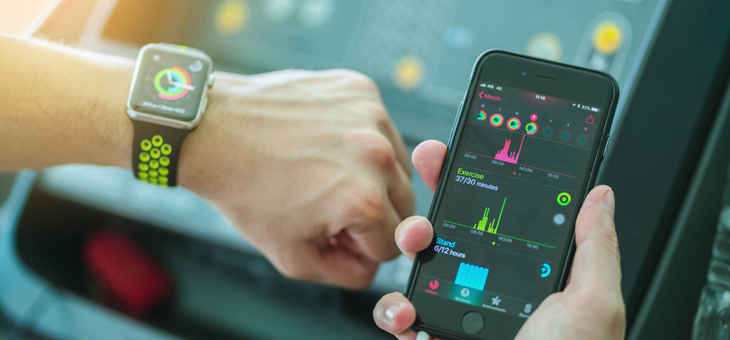Are you confused by all the marketing and promises made about health and fitness devices such as the Apple Watch?
How can you tell which ones will deliver the best results for you, while still being easy to understand and operate?
The Australian Institute of Fitness (AIF) has released its top 10 health and fitness wearables for everyday consumers, according to a recent survey of leading industry experts and professionals.
Read more: How to extend the life of your laptop battery
From functionality, user-friendliness, tracking and data capabilities to comfort, form, versatility and overall performance, the survey identified the best wearables for Australians.
The survey saw the Apple Watch top the list in the overall performance category, with 24.2 per cent of votes, followed closely by the Garmin Watch with 22.5 per cent of the vote.
The Fitbit Watch came in at No. 3, with the Samsung Galaxy Watch (No.4) and Whoop Strap (No. 5) rounding out the top five.
Other contenders included Motorola Moto, Huawei, Fossil Sport, Chest Strap and smart clothing.
Read more: Pros and cons of a ‘stranger’ in the house
Across key capability categories, the Apple Watch was voted the best wearable for weight loss, user friendliness and form and comfort, while the Garmin Watch topped the categories for improving overall fitness, and learning to run/improving running performance.
In terms of sleep monitoring, the Whoop Strap was ranked No. 1.
The survey follows 2020 search data analysis by comparison service Uswitch, which found that Australia has one of the highest search volumes for health apps in the world.
Read more: How to keep your phone sanitised
Uswitch revealed that Australia’s search volume per capita placed Australia at the top of the list of countries most concerned about tracking health data.
Despite growing demand, 87.5 per cent of AIF’s survey respondents believed that most Australian consumers don’t understand and/or utilise the depth of the capabilities of their wearable health and fitness devices.
The survey’s overwhelming consensus was that wearable users could unlock so much more potential to help them optimise their health, fitness and performance, if they were better informed on how to use their device.
The survey’s respondents strongly agreed (79.1 per cent) that the everyday Aussie fitness enthusiast is mostly drawn to user-friendly capabilities such as customisable display features and long battery life, over tech features such as built-in speaker for voice command and enhanced sleep tracking.
Top five best overall performance
- Apple Watch (24.2 per cent)
- Garmin Watch (22.5)
- Fitbit Watch (14.5)
- Samsung Galaxy Watch (11.2)
- Whoop Strap (9.6)
Top three most value features
- Long battery life
- User friendly display
- Heart rate monitoring capability
Best wearable across key capability categories
- Weight loss – Apple Watch
- Improving overall fitness – Garmin Watch
- Learning to run/improving running performance – Garmin Watch
- Sleep monitoring – Whoop Strap
- User friendliness – Apple Watch
- Form and comfort – Apple Watch
- Accuracy of tracking data – Garmin Watch
AIF’s experts predicted that in-ear fitness trackers with biosensors; hologram personal trainers; implantables; and contact lenses with built-in virtual assistants, would all be potential innovations in the global health and fitness wearable market.
AIF chief executive Steve Pettit said the growth of the wearable fitness market was a positive sign for Australians addressing future health problems.
“Wearable data is empowering people of all ages and fitness levels to improve their health, fitness and general wellbeing like never before,” Mr Pettit said.
“They are also giving us much more oversight and insight into what is going on with our bodies day to day, so it will be interesting to see if this results in any improvements in broader health categories – for example, in obesity and chronic disease rates.
“In future, the key to maximising the potential value of health and fitness wearables will lie largely in consumers and fitness professionals educating themselves about the full range of capabilities their wearables possess.
“Most Aussies have only scratched the surface – so we certainly have some exciting times ahead!”
What could be used better?
The AIF’s head of training, Kate Kraschnefski, said some of the most commonly misunderstood capabilities of health and fitness wearables included how to effectively utilise HR (heart rate) training zones and heart rate variability (HRV).
“Many users don’t fully understand how HR training zones – which are a staple of many health and fitness wearables – can provide real-time feedback regarding the intensity and energy systems targeted within their session,” Ms Kraschnefski explained.
“For endurance enthusiasts, utilising this function properly is like having a personal trainer running right beside you telling you exactly how hard you’re working and whether you need to put the pedal to the metal, or pull the gas off a little.”
Do you own a health wearable? Do you think you are getting the most out of your device?
If you enjoy our content, don’t keep it to yourself. Share our free eNews with your friends and encourage them to sign up.

